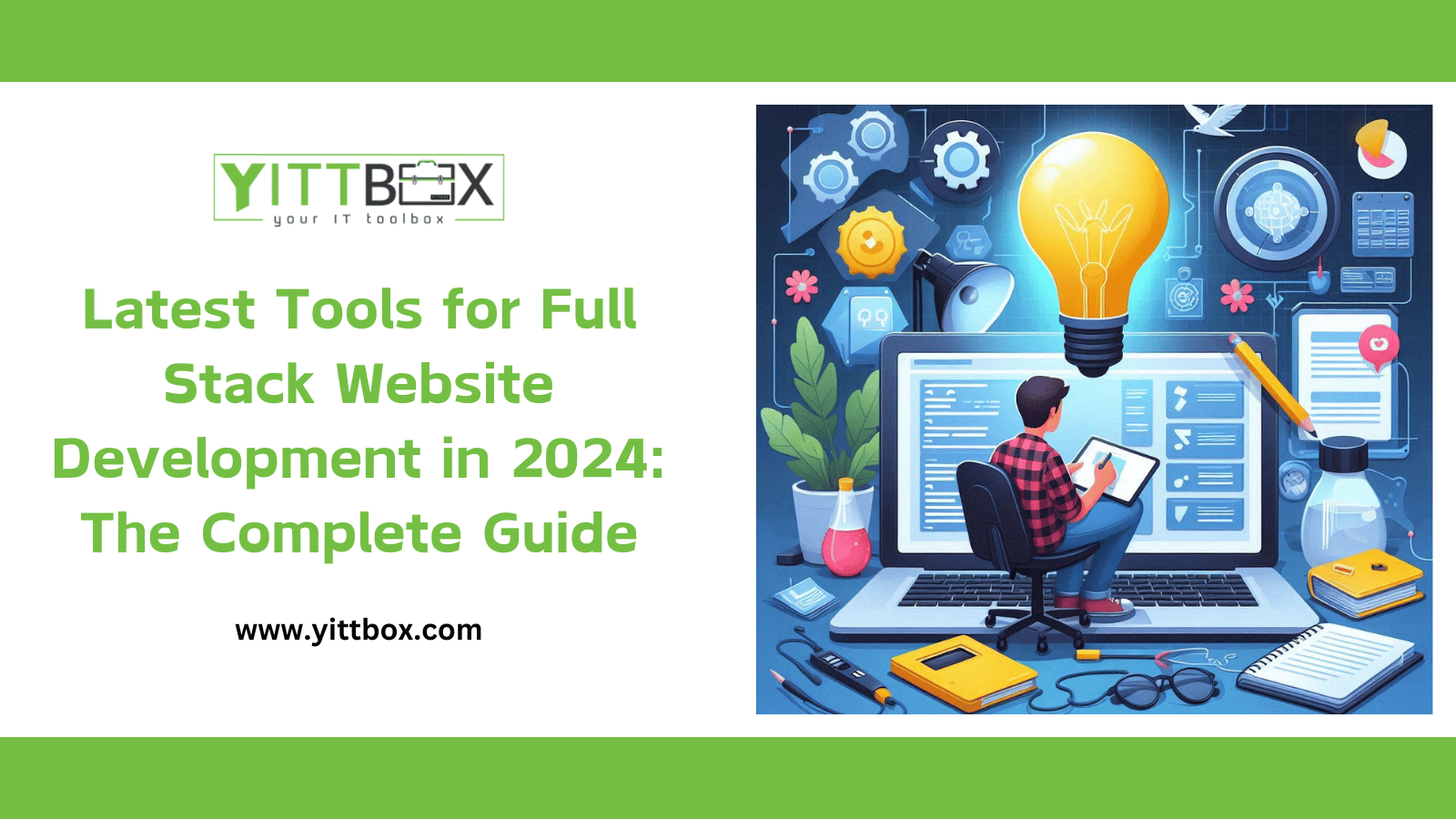Latest Tools for Full Stack Website Development in 2024: The Complete Guide
The web development landscape is evolving rapidly, and staying updated with the latest tools is critical for developers to build efficient, scalable, and maintainable websites. Full stack development, which combines both frontend and backend technologies, offers a wide array of tools that make it easier to build responsive, dynamic, and high-performing web applications.
In this article, we’ll explore the latest tools for full stack website development in 2024, covering both frontend and backend technologies, databases, API tools, and more.
Frontend Development Tools
The frontend is what users see and interact with. Here are some of the most widely used frontend tools that dominate 2024:
1. React.js
React.js continues to be a favorite among developers, offering a component-based architecture that simplifies UI development. With React, you can build dynamic web applications with fast, efficient rendering.
- Why use it: React’s virtual DOM improves performance, and its extensive ecosystem includes libraries like Redux and React Router.
- Popular Use Cases: Facebook, Instagram, Airbnb.
2. Vue.js
Vue.js is a progressive framework known for its simplicity and flexibility. It's perfect for projects that require rapid prototyping and allows for incremental adoption in legacy projects.
- Why use it: Vue offers a smooth learning curve and excellent documentation, making it easier to pick up.
- Popular Use Cases: Xiaomi, Alibaba, Grammarly.
3. Svelte
Svelte is a rising star in the frontend development world. Unlike other frameworks, it shifts much of the work to the build step, resulting in leaner, faster code that runs in the browser.
- Why use it: Smaller bundle size and improved performance compared to React or Vue.
- Popular Use Cases: The New York Times, Rakuten.
4. Tailwind CSS
Tailwind CSS offers a utility-first approach to styling, enabling developers to build custom designs without leaving their HTML file. This modern approach allows for faster development without the need for writing custom CSS.
- Why use it: Tailwind provides flexibility and ease of use without sacrificing performance.
- Popular Use Cases: GitHub, Kickstarter.
5. Next.js
Next.js is a popular React framework that supports server-side rendering (SSR), static site generation (SSG), and automatic code splitting. It is optimized for performance and SEO, making it ideal for large-scale applications.
- Why use it: Built-in routing, API support, and full-stack capabilities make it an all-in-one solution.
- Popular Use Cases: Hulu, TikTok, Nike.
Backend Development Tools
The backend is responsible for managing databases, server logic, and APIs. Below are the top backend tools that every full stack developer should know:
1. Node.js
Node.js is a JavaScript runtime that allows you to build fast, scalable network applications. Its event-driven architecture makes it suitable for handling real-time applications like chats and gaming platforms.
- Why use it: Non-blocking, event-driven architecture supports thousands of connections simultaneously.
- Popular Use Cases: Netflix, LinkedIn, Uber.
2. Deno
Deno is a new competitor to Node.js, created by the original author of Node. It fixes many of the shortcomings of Node by providing better security, native support for TypeScript, and first-class support for ES Modules.
- Why use it: Secure by default, supports TypeScript out of the box.
- Popular Use Cases: Real-time applications, microservices.
3. Express.js
Express.js is a minimal and flexible Node.js framework that provides a robust set of features for building APIs and web applications. It's lightweight yet powerful, making it a top choice for backend development.
- Why use it: Easy to learn and fast to set up, supports middleware and templating.
- Popular Use Cases: Medium, PayPal.
4. Nest.js
Nest.js is a Node.js framework for building scalable and maintainable server-side applications. It's built with TypeScript and provides excellent support for building microservices.
- Why use it: Great for building enterprise-grade applications, modular architecture.
- Popular Use Cases: Trivago, Adidas.
5. Django
Django is a high-level Python framework that encourages rapid development and clean, pragmatic design. It comes with many built-in features like authentication, admin panels, and form validation.
- Why use it: Perfect for building secure and scalable web applications quickly.
- Popular Use Cases: Instagram, Pinterest, YouTube.
Databases for Full Stack Development
Databases store the data that powers your web application. Choosing the right database is crucial for scalability and performance.
1. PostgreSQL
PostgreSQL is an open-source, highly reliable relational database known for its performance and advanced features like JSON support and ACID compliance.
- Why use it: Best for complex queries and scalability, highly customizable.
- Popular Use Cases: Apple, Instagram, Uber.
2. MongoDB
MongoDB is a NoSQL database designed for handling unstructured data. It stores data in JSON-like documents, making it ideal for projects that require schema flexibility.
- Why use it: Great for modern, cloud-based applications with dynamic data models.
- Popular Use Cases: eBay, Lyft, Coinbase.
3. Supabase
Supabase is an open-source alternative to Firebase that leverages PostgreSQL for its database. It provides real-time APIs, authentication, and file storage out of the box.
- Why use it: Easy to set up, built-in authentication, serverless.
- Popular Use Cases: Real-time applications, e-commerce platforms.
API and Serverless Tools
APIs act as the bridge between frontend and backend systems. With serverless technologies, developers can write backend logic without worrying about server management.
1. GraphQL
GraphQL is a modern API query language that allows clients to request only the data they need, reducing payload size and improving performance.
- Why use it: Reduces over-fetching, great for complex applications with varied data needs.
- Popular Use Cases: GitHub, Shopify, Twitter.
2. AWS Lambda
AWS Lambda is a serverless compute service that lets you run backend code without provisioning or managing servers. It automatically scales based on demand.
- Why use it: Cost-efficient, supports microservices architecture, scales automatically.
- Popular Use Cases: Real-time data processing, microservices.
Version Control and CI/CD Tools
Maintaining a smooth development workflow is key to building scalable applications. Version control and CI/CD (Continuous Integration/Continuous Deployment) pipelines make it easier to track changes and automate deployment.
1. GitHub
GitHub is a cloud-based version control system for tracking code changes. It also integrates with various CI/CD tools to streamline the development process.
- Why use it: Provides collaboration tools, seamless CI/CD integration.
- Popular Use Cases: Open-source projects, enterprise development.
2. Docker
Docker is a containerization platform that helps developers package their applications and dependencies into containers, ensuring consistent environments from development to production.
- Why use it: Portability, faster deployment, isolation of services.
- Popular Use Cases: Microservices, CI/CD pipelines.
Conclusion
Full stack website development in 2024 is a mix of cutting-edge tools and frameworks that make it easier to create highly responsive, scalable, and efficient web applications. Whether you're building a frontend with React or Vue, developing APIs with Express or Django, or managing databases with PostgreSQL or MongoDB, there’s a tool for every part of the development stack.
By staying up-to-date with these tools, developers can deliver optimized, high-performance websites and applications that meet the demands of modern users.







